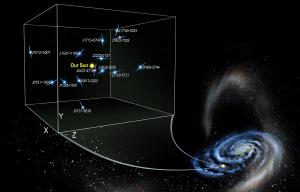Blog
Pulsar Positioning
12 January 2021
 Dana Berry, IAS
Dana Berry, IASAs our Sun moves along its orbit in the Milky Way, it is gravitationally tugged by nearby stars, nebulae, and other masses. Our galaxy is not a uniform distribution of mass, and our Sun experiences small accelerations in addition to its overall orbital motion. Measuring those small tugs has been nearly impossible, but a new study shows how it can be done.1

Credit: S. Klepser, MAGIC Collaboration
The team focused on binary pulsars. These are pulsars that have an orbiting companion. Pulsars emit bursts of radio light at regular intervals. The pulses are so regular they can serve as a kind of celestial clock. As a binary pulsar orbits its companion, the timing of the pulsars varies slightly as the signal is Doppler shifted by the motion of the pulsar relative to us. By measuring the timing shift, you can calculate the acceleration of the pulsars.
In this study, the team calculated the relative motion of 14 pulsars, which gave them a measure of their accelerations relative to the solar system. It’s an impressive feat because these accelerations are extremely tiny. From these accelerations, the team measured the mass density within the plane of the Milky Way.
 ESA - C. Carreau
ESA - C. CarreauStars don’t orbit the galaxy in simple circles. Instead, their motion bobs up and down through the galactic plane as the mass in the plane pulls them gravitationally. The pulsars observed by the team also do this. By measuring their accelerations the team could determine how strongly the galaxy pulls on them, and thus the mass within the galaxy.
This work is important because it could help us understand the distribution of dark matter within our galaxy. We know that most of our galaxy’s dark matter is distributed in a halo surrounding the galaxy, but if we can determine how much dark matter is in the galactic plane it will help us understand how dark matter clumps together within a galaxy. Knowing this distribution could also help us understand how dark energy expands the universe. One of the things this initial study found was that mass within the galactic plane is not evenly distributed, which could be a dark matter signal.
Sukanya Chakrabarti, et al. “A measurement of the Galactic plane mass density from binary pulsar accelerations.” arXiv preprint arXiv:2010.04018 (2020) ↩︎